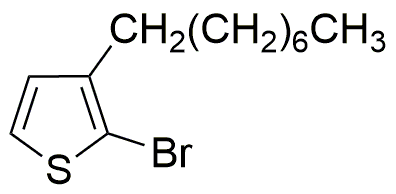2-Bromo-3-n-octylthiophene is widely utilized in research focused on:
- Organic Electronics: This compound serves as a key building block in the development of organic semiconductors, which are essential for creating flexible and lightweight electronic devices such as organic light-emitting diodes (OLEDs) and organic photovoltaics (OPVs).
- Conductive Polymers: It is used to synthesize conductive polymers that can be applied in various fields, including sensors and energy storage devices, enhancing their conductivity and overall performance.
- Photovoltaic Applications: Researchers leverage its properties to improve the efficiency of solar cells, making renewable energy solutions more viable and effective.
- Materials Science: The compound is explored for its potential in developing advanced materials with tailored electronic properties, which can be beneficial in creating next-generation electronic components.
- Research in Organic Chemistry: It serves as a valuable reagent for synthesizing other complex organic molecules, facilitating advancements in chemical research and development.
General Information
Properties
Safety and Regulations
Applications
2-Bromo-3-n-octylthiophene is widely utilized in research focused on:
- Organic Electronics: This compound serves as a key building block in the development of organic semiconductors, which are essential for creating flexible and lightweight electronic devices such as organic light-emitting diodes (OLEDs) and organic photovoltaics (OPVs).
- Conductive Polymers: It is used to synthesize conductive polymers that can be applied in various fields, including sensors and energy storage devices, enhancing their conductivity and overall performance.
- Photovoltaic Applications: Researchers leverage its properties to improve the efficiency of solar cells, making renewable energy solutions more viable and effective.
- Materials Science: The compound is explored for its potential in developing advanced materials with tailored electronic properties, which can be beneficial in creating next-generation electronic components.
- Research in Organic Chemistry: It serves as a valuable reagent for synthesizing other complex organic molecules, facilitating advancements in chemical research and development.
Documents
Safety Data Sheets (SDS)
The SDS provides comprehensive safety information on handling, storage, and disposal of the product.
Product Specification (PS)
The PS provides a comprehensive breakdown of the product’s properties, including chemical composition, physical state, purity, and storage requirements. It also details acceptable quality ranges and the product's intended applications.
Certificates of Analysis (COA)
Search for Certificates of Analysis (COA) by entering the products Lot Number. Lot and Batch Numbers can be found on a product’s label following the words ‘Lot’ or ‘Batch’.
Numéro de catalogue
Numéro de lot/série
Certificates Of Origin (COO)
This COO confirms the country where the product was manufactured, and also details the materials and components used in it and whether it is derived from natural, synthetic, or other specific sources. This certificate may be required for customs, trade, and regulatory compliance.
Numéro de catalogue
Numéro de lot/série
Safety Data Sheets (SDS)
The SDS provides comprehensive safety information on handling, storage, and disposal of the product.
DownloadProduct Specification (PS)
The PS provides a comprehensive breakdown of the product’s properties, including chemical composition, physical state, purity, and storage requirements. It also details acceptable quality ranges and the product's intended applications.
DownloadCertificates of Analysis (COA)
Search for Certificates of Analysis (COA) by entering the products Lot Number. Lot and Batch Numbers can be found on a product’s label following the words ‘Lot’ or ‘Batch’.
Numéro de catalogue
Numéro de lot/série
Certificates Of Origin (COO)
This COO confirms the country where the product was manufactured, and also details the materials and components used in it and whether it is derived from natural, synthetic, or other specific sources. This certificate may be required for customs, trade, and regulatory compliance.


